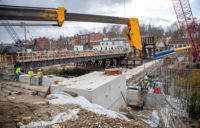After years of delays, structural completion of Germany’s 2,257-ft-long Leverkusen bridge will be celebrated on Sept. 5 as construction of its adjacent cable-stayed twin is about to start.
Originally intended to open in 2020, the new bridge's completion was delayed by a dispute over Chinese steelwork quality. By the time the original contract was terminated in 2020, the contractor PORR Deutschland GmbH. had largely completed foundations, having secured the job in 2017.
A new team of Hochtief A.G. Max Bögl Group, France’s Eiffage Métal S.A., and its affiliates Iemants N.V. and SEH Engineering GmbH., took on the task to complete the job in 2021 under a contract then valued at $236 million.
With the first bridge due to open this year, the highway authority Autobahn GmbH. (AG) expects demolition of the old crossing to start early in 2024. By then, a new grouping largely of the original consortium members will be in the early stages of building the second twin.
AG’s Rhineland division this July named a team of SEH Engineering GmbH. with Hochtief Infrastructure GmbH., Plauen Stahl Technologie GmbH., Max Bögl GmbH and Co. KG., and ZSB Zwickauer GmbH for special steel construction as winner of the contract. AG valued the contract at $465 million.
The consortium says it will source the structure’s 17,600 tons of steelwork in Germany and have it delivered by barge along the Rhine.
Conceptually designed by Ingenieurbüro Grassl GmbH., the twin crossings include 920-ft-long, 110.5-ft-wide central main spans supported from A-frame pylons on either side, rising nearly 200 ft above the deck. The decks are formed by 20-ft-wide by 12-ft-deep steel box edge girders linked by steelwork cross beams.
Carrying the A1 highway over the Rhine River between Leverkusen and Cologne, the two eight-lane bridges will replace an elegant, 58-year-old cable-stayed structure, designed by the eminent engineer Hellmut Homberg.
Designed for 40,000 vehicles a day, the old bridge is suffering various structural flaws, according to AG. The six-lane crossing carried three times the expected traffic before weight restrictions were imposed in 2016, it adds.




Post a comment to this article
Report Abusive Comment